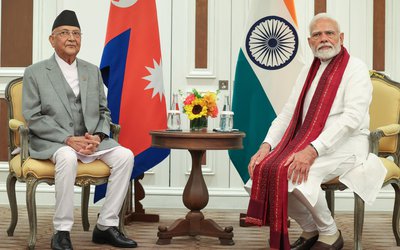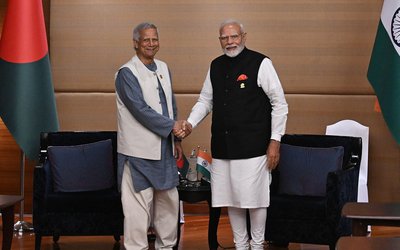More on Interview




How do you see the state of banking sector at present?
Well, the banking sector is in a big stress at the moment, as deposit growth is not as fast as the loan growth due to several factors. The government spending is too low and savings growth has not picked up as expected. These are the two main problems right now. There is also the debate that banking sector has engaged in unproductive lending, such as, in auto and margin lending. To some extent that might be true, but one must realize that forty percent of the government revenue comes from auto imports. If the central bank wants to curtail the unproductive lending, rather than having loan to value ratio limits and invaded way to tackle capital adequacy, there are ways. If the central bank wants to make it expensive and discourage bank lending to a certain sector, they should increase capital adequacy for these things. For auto loan 100, they can make 130 or 150 just like real estate loan so that the banks will have used up their valuable capital if they want to get into this. Putting these others crops like loan to value ratio or saying you can loan up to 50 percent of saving in particular sector is not a good idea. People need financing -- this is what banking is all about, giving people access to finance.
How do you see the present liquidity crisis? Will it have a longer implications or shorter?
It will have longer implications for a while because it will be now thickening in expensive deposits as some banks are taking the deposits with 10 percent for three years. Definitely, it will have a long term impact on our cost structure. So I think that we won’t be able to go back to six percent in TR or lowest rate around seven or eight percent, six to seven months.
What do you see as the reasons behind the sudden crisis in liquidity?
I think everyone hoped that the government would start spending and the development activities would be in full swing. Right now, that has not begun. As we see, may be capital expenditure will start at the end of the current fiscal year. Even then, look at the uncertainty in the change of government. Who is going to be leading? Whether the government is going to change or election is going to happen? As the level of uncertainty is so high, it distracts the development activities. I am sure all the government ministries and departments are more consumed by the current political scenario than the project implementation. If there is a change of government, there will be change of secretaries and department heads. Once again everything will be pushed back. We don’t see the capital expenditure growing beyond the 30 percent which Nepal has grown in the past six years. That will further add stress in deposits in the bank.
It is reported that the central bank is blaming the commercial banks as heavily investing in real estate and housing sector. How do you look at this statement?
Blaming banks for lending is not really wanted, as this is what we do. Again, I want to stress that if the central bank fails, they don’t want to see loan in certain areas, they should increase the capital adequacy in those areas, so banks handle capital and risk. All the banks will say I don’t want to use all the capital. There is a better route rather than put the limit.
Given the current trend, there is no other way to increase the capital expenditure. What do you suggest to bring immediate changes?
There are two issues: one is liquidity and the other is how to soar up liquidity. I think the concern of the government and central bank is the rise in the interest rate. We had this kind of a situation before. With the coordination from government, the central bank, they took an initiative. Rameshwor Khanal was the finance secretary at that time, with whom we had a dialogue. After this, he came to the conclusion that the economy could not be sustained. What Ministry of Finance and central bank did was inviting all the depositors’ institutions and asking them to cap their demands for interest rate. In that way Employment Provident Fund, Citizen Investment Board and Army did not ask banks for more than 12 percent. That way the crisis slowly scaled down. May be this kind of coordination is needed now, not just sitting around and blaming the banks for the present scenario. I don’t think this is part of the solution.
How is the ratio of interest rate now?
Banks have increased the saving interest rate by .75 basis points. It is quite a big increase. If you look at Himalayan Bank, sixty percent of our deposits are in savings. So that cost of our deposit base has increased by .75 percent. It will be a huge amount. Politicians and central bank should realize that the savings will increase as we increase the interest rates. If you increase the interest rate by one or two percent, it will not be a big increase as people will see interest as a checking ground. If there is a withdrawal limit in saving, let's say 25 or 50 thousand a month, then it will make sense in putting higher interest rates. At the moment we are allowing unlimited amount from saving accounts, this is making products become more unstable.
Do you see any link between soaring land prices and liquidity crisis?
Yes there is a link. In the past also what we did see was the asset trash like the prices of land and share soared, we did see a slowdown of the growth of deposit. What would happen if those people who have real estate exposure to the bank have not repaid and kept the money outside? They know that bringing down limits to the bank, they will not be reinstated. This is the reason in outstanding and rolling it over outside. Due to the lack of confidence in the political scenario, people are not putting in the money. Similarly, the government expenditure is also a big issue. This trend has been going on for some time and it is not sudden. If you look at Himalayan Bank, I have not fulfilled the target of deposit lending and deposit mobilization. I am slightly under and I have suddenly felt the stress. We have seen the growth in the last five years and now we are suddenly in slowdown. What I want to say is that Ministry of Finance and Central Bank have to realize that the deposits have gone down and should find the cause of slowdown rather than blaming banks.
International financial institutions like IMF, The World Bank and Asian Development Bank has been issuing warning that the decline in the remittances and low capital expenditure will have far reaching consequences. Why did Nepal’s banking sector ignore this?
That is true. One of the problems is that we have very low saving rates and consumption is very high. Low saving rates is also something worrying. Ministry of Finance and Central Bank need to look at it. Low saving rates correlate to low deposits. Nepalese are more consuming than saving. That is Nepalese phenomenon. In Japan, they save too much and don’t spend but here people spend and don’t save.
We have to realize that the formal economy of Nepal is also very small as only a small fraction of people pay taxes. Why are people not coming into the formal sector? This issue needs to be addressed.
What is the state of the Himalayan Bank?
The Himalayan Bank has also faced some stress. Our traditional depositors are lured away by other banks with very high rates of interest. We are meeting with central bank and raising the issue of high interest rate given by development banks and financial institutions. We are capping the rate at 12 percent.
How do you see the future growth?
Growth is dependent upon three factors. One is the weather, the other is government spending and the third is private sector. Right now weather and private sector are in problems and the government needs to step in. There is need of partnership and coordination. NPC and Ministry of Finance have to wake up. Along with politicians, bureaucrats also need to take the issue seriously to achieve the economic progress.






